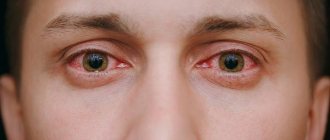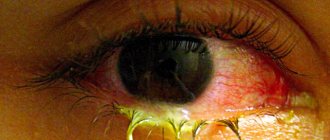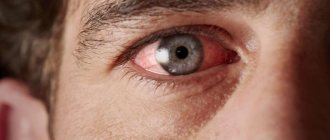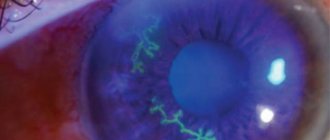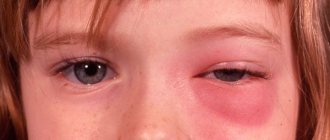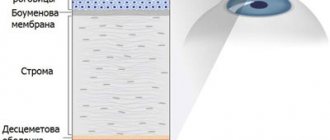More than 45 different viruses can cause conjunctivitis, researchers say. This disease causes severe discomfort, most often affects children, but often occurs in adult patients.
In terms of prevalence, viral conjunctivitis is inferior to bacterial conjunctivitis. However, due to its high contagiousness, outbreaks of the disease are extremely difficult to control: isolated cases of viral conjunctivitis quickly develop into epidemic ones, entailing various socio-economic consequences - from the introduction of quarantines to a sharp increase in temporary disability.
From this article you will learn about what viral conjunctivitis is, how to distinguish it and react correctly if suspicious symptoms appear.
Viral conjunctivitis
is an inflammatory disease of the conjunctiva, the membrane lining the outer surface of the eyeball and the inner surface of the eyelids, caused by a virus.
What is viral conjunctivitis
Among the many eye pathologies, conjunctivitis is the most common - an inflammatory disease of the conjunctiva, the outer transparent mucous membrane covering the inner surface of the eyelids, the sclera. Normally, the membrane is clean, unclouded, but when it is diseased, it becomes reddened.
There are three main types of illness, which are divided depending on the cause of occurrence and the causative agent: viral, allergic, bacterial. A special place is occupied by atypical chlamydial, as well as fungal. This disease is epidemic in nature, since the infection is easily spread by dirty hands.
Unexpectedly, unpleasant sensations may arise in the eyes: a sensation as if sand had been poured in. Discomfort from pain deprives a person of living a full life and the ability to clearly see the world around him. The disease spreads easily, is contagious, and therefore poses a great health hazard.
It is enough to rub your eyes with dirty hands so that bacteria and viruses get onto the mucous membrane. The disease can affect people of all ages, even the youngest children. The following factors can provoke the development of the disease: damage to the lacrimal ducts, metabolic disorders, damage to the nasal mucosa, vitamin deficiency.
The article details the reasons; symptoms; methods of treatment, prevention, since malaise occurs with equal frequency in adults and children.
Ways of transmission of the disease
Viral conjunctivitis is an acute inflammatory disease of the mucous membrane of the eye, which is caused by infections. Ailments are caused mainly by adenoviruses, herpes by viruses.
The disease is very contagious throughout the entire period of illness, which is 10-12 days. You can catch it through direct contact with a patient, as well as through household items - through contact and household contact: a towel, shared underwear, door handles, shared work supplies, dirty hands.
Ideally, a sick person should be hospitalized in order to isolate as much as possible from others. Otherwise, an epidemic may develop. The bacterium is transmitted by contact. Remember, the disease affects both eyes, even if initially signs appear in only one, over time the second one becomes ill.
A distinctive feature of ill health is the periodicity of the development of adenoviral and enteroviral epidemics. As a result, parallel infection of the human upper respiratory tract occurs. If the cause of viral conjunctivitis is herpes, the disease is transmitted by airborne droplets.
Viral conjunctivitis symptoms and treatment are specific and depend on the causative agent of the bacillus, and therefore it is very important to understand the varieties.
Causes
Viral conjunctivitis can be caused by enterovirus, adenovirus, herpes simplex, as well as systemic viral infections. You can become infected by contact, through hands and close touch.
A bacterial infection can also cause the development of conjunctivitis. Bacteria enter the eye from the external environment or from chronic foci of infection present in the body. Microtraumas, as well as ophthalmological diseases, increase the risk of contracting a bacterial infection.
The disease may also be of an allergic nature. Allergic conjunctivitis can be caused by various types of allergens: dust, pollen, gases, etc.
Types and forms of viral conjunctivitis
There are many known microorganisms that cause health problems. Depending on the pathogen, the following viral conjunctivitis is distinguished:
- Adenoviral;
- Herpetic;
- Epidemic.
Adenoviral - develops against the background of inflammatory pathology of the upper respiratory tract - pharyngitis, a sharp increase in temperature occurs, and therefore it is called pharyngoconjunctival fever.
Three forms of this type are known:
- The catarrhal form is characterized by a mild course, mild inflammation, a minimal amount of mucous discharge, and no redness of the membrane is observed. The illness continues for a week.
- The filmy, rare form is characterized by the appearance of a thin film of a grayish-white hue on the mucous membrane. The film is easily removed with a cotton swab. Sometimes there is a bleeding surface under the film. After the film disappears, no scars remain.
- The epidemic form develops when the Koch-Wicks bacillus enters the human body. The source of infection is a sick person who is a carrier of microbes. Flies play a huge role in the spread of the disease. The incubation period lasts four days, and the malaise lasts two months.
- The follicular form is marked by the appearance of bubbles of different sizes on the mucous membrane.
Herpetic conjunctivitis is an acute inflammation of the connective tissue of the eye membrane caused by a herpes virus. It is impossible to cure it completely, so relapses of the disease occur from time to time. The virus infects the cornea, the disease is severe, and vision is sharply reduced until blindness occurs.
Various unfavorable conditions can activate the bacterium that penetrates the eye tissue, causing inflammation of the conjunctiva, skin of the eyelids, cornea, and internal parts of the organs of vision: overheating, hypothermia, high doses of alcohol, stress, surgery, trauma.
According to the course of the disease there are:
- acute – a person falls ill suddenly, the symptoms are severe and disappear after treatment;
- subacute – characteristic features are weakly expressed, disappear after treatment;
- chronic - mild symptoms are observed almost constantly, after treatment there is a temporary improvement in the condition.
According to the route of transmission of the pathogen, they are distinguished:
- contact route of transmission - the disease develops directly through contact with the patient - with his infected mucous discharge; this route of infection is characteristic of bacterial conjunctivitis;
- Airborne transmission of infection occurs through contact with tears, saliva, and feces of an infected person.
Types of conjunctivitis
What causes the disease
Various microorganisms influence the occurrence of the disease. The causes that provoke the formation of poor health are adenoviruses and herpes viruses.
Factors contributing to the growth of bacterial conjunctivitis: hypothermia, decreased immunity, excessive exposure to sunlight, past infections, lack of adequate nutrition.
A special type of adenovirus is also the cause of epidemic keratoconjunctivitis and is characterized by rapid spread, which poses a danger to groups and family members.
Conjunctivitis can develop with influenza, measles, rubella, mumps, and chickenpox. The maturation of the disease leads to damage to the conjunctiva, its inflammation, and swelling. This is a common cause of the painful condition.
The following factors increase the formation of pathology: a general decrease in the body’s defenses, a violation of the integrity of the mucous membranes, a violation of the body’s metabolic processes, and hypovitaminosis. They increase the body’s susceptibility to the effects of microbes, facilitate their access and consolidation in the human body.
150 viruses have been studied, most of them are dangerous to health and harm all systems. Pharyngoconjunctival fever and epidemic viral keratoconjunctivitis are caused by bacteria known since the last century.
Diagnosis of the disease
Differential diagnosis of viral conjunctivitis occurs primarily between other types of the disease. Among them, the following should first be highlighted:
- bacterial conjunctivitis;
- non-infectious conjunctivitis.
Most often, the disease is determined by its clinical signs. In rare cases, growth of the virus occurs after tissue culture collection. This method of examination is prescribed extremely rarely.
The following methods are also used in the diagnostic process:
- PCR (polymerase chain reaction);
- Immunological rapid analysis.
The above examination methods are most often used in cases where the patient has a rather serious condition, as a result of which it is necessary to exclude other diseases of the ophthalmological system.
The clinical sign that distinguishes viral and bacterial conjunctivitis is the presence of purulent contents in the eye.
If the patient has a fear of light, he is examined using a slit lamp, as well as staining with fluorescein. If the patient has epidemic keratoconjunctivitis, the drug causes pinpoint pigmentation.
Symptoms of viral conjunctivitis
The incubation period ranges from five to twelve days. It is preceded by contact between a healthy person and an infected person. Signs of pain disappear on their own within a week. You should not neglect them, as they can harm your health and lead to chronicity.
The disease begins with redness of the membranes of the eyes, photophobia, and excessive lacrimation. The mucous membrane turns red, the eyelids swell. Small follicles and pinpoint hemorrhages appear on the mucous membrane. One eye is affected, then the other, or both at the same time.
Depending on the type of virus - the causative agent, the following symptoms of viral conjunctivitis may appear: a feeling of sand, pain, burning, mucous discharge, sticking of cilia, the appearance of purulent crusts, chills, drowsiness, weakness, runny nose, cough, sore throat, sleep disturbance.
The overall health suffers: regional lymph nodes become enlarged; temperature rises; symptoms of intoxication increase. If the causative agent of the disease is a herpes virus, then herpetic blisters appear. The disease is considered female. Once bacteria get on the shadows and mascara, they multiply and cause inflammation.
If left untreated, small erosions begin to form on the conjunctiva, developing into ulcers. Therefore, in order not to harm your vision, contact a specialist in a timely manner for the necessary examination and therapy.
Symptoms
Let's look at the main signs of eye conjunctivitis in adults:
- formation of follicles on the eyelids;
- redness;
- lacrimation;
- itching;
- serous discharge;
- enlargement of regional lymph nodes;
- photophobia;
- foreign body sensation;
- decreased vision.
Watery eyes and periodic itching are the first symptoms of viral conjunctivitis.
Diagnosis of viral conjunctivitis
It is necessary to carefully approach your health status. People pay little attention to the causes and signs of the disease. They don't realize that many are life-threatening. There are ailments that do not manifest themselves in any way at first, and then it is too late to treat.
Each pathology has certain symptoms and characteristic external signs. Their identification is the first step of diagnosis. Therefore, you should undergo regular examinations to prevent a painful condition.
Conjunctivitis is determined when examining a patient by an ophthalmologist based on sensitivity, enlargement of the parotid lymph nodes; according to clinical signs; laboratory cytological, virological, serological studies.
Sometimes a scraping is required to determine the type of cellular reaction of the macroorganism, the appearance of the microorganism, for inoculation in culture media for growing bacteria, and their accurate identification.
Diagnostics
Conjunctivitis is diagnosed by examination at a slit lamp, but in some cases the doctor can take a smear (if it is necessary to determine the type of microorganism and the nature of the cellular reaction of the macroorganism in order to prescribe effective treatment). In recent years, cytological, immunofluorescent (IFA) and enzyme-linked immunosorbent assay (ELISA) studies have been increasingly carried out.
Treatment of conjunctivitis
Treatment methods depend directly on the type, but in any case it is an integrated approach: antiviral therapy, relief of painful symptoms, prevention of secondary bacterial infection.
How and with what to treat viral conjunctivitis: regularly treat the eyes with antiseptic solutions every day; use antiviral drugs; strengthen the immune system. The most effective drug is considered to be ophthalmoferon drops, which simultaneously have antibacterial and antiviral activity.
Before going to bed, you should put a medicine with antiviral activity behind your eyelid. During the day, you should wash your eyes with antiseptics. Each eye needs a separate swab. To reduce discomfort, natural tear eye drops are recommended. To strengthen the immune system, increase the content of fruits, vegetables, and vitamins in the diet.
Acute viral conjunctivitis requires special treatment: purulent discharge is eliminated, since the mucous membrane is a favorable environment for the development of a pathogenic infection. To do this, use antibacterial eye drops, boron solution, and viruscidal drugs against re-infection.
Timely treatment of viral conjunctivitis is quick and successful. If you neglect it, you can develop a chronic form that is difficult to treat. Regardless of the nature of the disease - allergic, bacterial, viral - treatment is aimed primarily at eliminating the cause.
Treatment and diagnosis
Typically, viral conjunctivitis goes away on its own within about 7-10 days. But there is no need to neglect the disease, as it can often cause serious complications or develop into a chronic form.
Attention! If conjunctivitis is not treated, various complications may develop, including keratitis. It can cause vision loss.
Keratitis is one of the complications
Only a doctor can make an accurate diagnosis; at home, a person is unlikely to be able to determine the type of conjunctivitis on his own. Diagnosis is carried out on the basis of a clinical assessment of the body’s condition. Sometimes, in order to accurately determine the type of disease, a special tissue analysis is required, but this procedure is rarely prescribed. To make a diagnosis, methods such as PCR and other immunological tests can be used. They are especially important in severe cases of the disease, as well as if it is necessary to identify other diseases. People suffering from photophobia must be examined using a slit lamp.
Attention! Treatment is prescribed by a doctor. And it will depend on the form of conjunctivitis.
Drops for conjunctivitis
To treat viral conjunctivitis, ointments and drops are used, often with corticosteroids. Therapy is also carried out to restore a person’s immunity, since conjunctivitis often develops precisely because the body lacks the strength to cope with the virus on its own. Taking vitamins and strengthening agents will be beneficial in any case. Symptoms of conjunctivitis can be relieved with warm compresses.
Table. Drops used for treatment.
| Name | Characteristic |
| Oftalmoferon | Drops based on interferon act well as an immunomodulator and are also effective against viruses and inflammatory processes. Used daily during the acute period of the disease - 2 drops about 6-8 times a day, after that - 1-2 drops 2-3 times a day. The course of treatment is 14 days. |
| Aktipol | An excellent option against adenoviruses, it eliminates redness and inflammatory processes well. Immunomodulator. Due to these drops, corneal regeneration processes are accelerated. The course of treatment is 7-10 days, 2 drops about 8 times a day. |
| Albucid | A wide-profile drug that can cope with any conjunctivitis. Fights well against microorganisms. The course of treatment is usually 7 days, but can be extended by a doctor. Drops are used daily up to 6 times (1 in each eye). |
| Poludan | An excellent option for drops for herpetic conjunctivitis. A drug based on endogenous interferons and cytokines. Used daily 6-8 times, a couple of drops during the acute period, then 3-4 times a day. In total - about 7-10 days. Acts quickly and effectively. |
Eye drops Poludan
If you have viral conjunctivitis, you should not touch your eyes with your hands; it is important to follow the rules of personal hygiene. During the period of illness, it is better to have your own individual towel, which no one else will use to dry themselves. Ointments will also help fight conjunctivitis.
Applying ointment for conjunctivitis
Table. Ointments against conjunctivitis.
| Name | Characteristic |
| Bonafton | Excellent fight against adenoviral conjunctivitis. Facilitates the course of the disease, relieves symptoms. It is recommended to use it daily for 10 days; apply the ointment 3 times a day, 0.1 g. |
| Tebrofen ointment | Perfect for combating any type of conjunctivitis. Suppresses the development of infection. It is recommended to use up to 3-4 times a day for 4 weeks. |
| Oxolinic ointment | An active and effective ointment that quickly penetrates the conjunctiva and has a negative effect on viruses. |
| Florenal | Suitable for the treatment of eye infections caused by herpes, smallpox, adenovirus, lichen. Use 2-3 times a day for at least 10 days. |
Indications and contraindications for Bonafton ointment
Drops and ointments during therapy
In the treatment of viral conjunctivitis, various medications are used: special antiviral drops with interferon; non-steroidal anti-inflammatory drugs to relieve inflammation; hormonal anti-inflammatory drugs; drops containing antibiotics; ointments.
Typically, medications are used as follows: wash the eye to remove purulent discharge with special antibacterial solutions; then use antiviral drops; After half an hour, antiviral ointment is applied.
Treatment is carried out only under the supervision of a doctor. The course of healing is three weeks. In severe cases, a month. The eyes should not be sealed, tied, or covered with compresses, as this will only create favorable conditions for inflammation.
A repeated consultation with an ophthalmologist is necessary if, despite strict adherence to all the specialist’s instructions, there is no improvement in the condition, new signs of the disease appear.
Eye hygiene is performed using a cotton swab, moving from the outer corner to the inner one. For the procedure, be sure to use a separate swab for each eye.
Remember that all types of viral conjunctivitis are contagious, transmitted by contact, and spread easily. Timely treatment will help avoid complications. Don't neglect your health.
Hemorrhagic conjunctivitis
The causative agents of the disease are enteroviruses - infectious agents transmitted by contact.
Enteroviral conjunctivitis is transmitted through eye drops, dirty hands, and personal hygiene products.
The disease is characterized by some seasonality. According to statistics, conjunctivitis appears in late summer and early autumn. Patients complain of the following symptoms:
- photophobia;
- pain and pain in the eyes;
- lacrimation;
- burning and tingling in the corners of the eyes;
- swelling;
- feeling of the presence of a foreign body;
- hemorrhage;
- mucopurulent discharge;
- follicular rashes.
In addition, the general condition worsens, malaise, headache, and fever appear. How many days does enteroviral conjunctivitis last? The disease lasts from ten days to a month.
First of all, the patient should be isolated due to its high contagiousness. The fight against enterovirus infection begins with the installation of antiviral agents into the conjunctival sac. Along with this, anti-inflammatory and antiallergic therapy is prescribed.
To prevent the addition of a bacterial infection, the doctor may decide to prescribe antimicrobial drops and eye ointments. Treatment lasts two weeks, even if the clinical symptoms have already passed.
To avoid relapse, you should maintain eye hygiene
How to distinguish viral and bacterial conjunctivitis
It is difficult to distinguish them. Only a doctor can do this after examining the patient. It is important to make a correct diagnosis, as the effectiveness of treatment depends on this. There are several known symptoms that independently determine the cause of the painful condition.
The viral type affects one eye, while the bacterial type affects both. With the bacterial form, pain is more pronounced than with a viral disease. The virus is constantly accompanied by severe itching.
In the bacterial form, pus is released, and after sleep the eyelashes stick together. With a viral illness, the secreted mucus does not stick the eyelashes together. The viral type is marked by severe redness and profuse lacrimation. In bacterial cases, the signs are not clearly expressed.
Differences between viral conjunctivitis and bacterial and allergic
Diagnosis of viral conjunctivitis is usually based on laboratory results. However, there are characteristic signs of each of the forms that allow the specialist to make an assumption about the nature of the disease after examination.
Differences between viral conjunctivitis
So, viral conjunctivitis differs from the bacterial form:
- The nature of the discharge.
- The degree of swelling of the eyelids: with the viral form the swelling is less.
- Changes in the lymph nodes.
With viral conjunctivitis, the discharge only sometimes contains small patches of pus, while the discharge with bacterial conjunctivitis is mostly purulent.
Typically, bacterial conjunctivitis does not affect them. The lymph nodes react to the viral form by becoming enlarged and painful.
Allergic conjunctivitis is also different from viral conjunctivitis. With allergies, the discharge is more abundant, viscous, resembling mucus. The lymph nodes are not tense, but the swelling is much stronger. In addition, allergic conjunctivitis is accompanied, unlike viral conjunctivitis, by severe itching.
Adenoviral conjunctivitis in children
This bacterium is transmitted only by airborne droplets. Affects eyes, nasopharynx. Most often it is epidemiological in nature. It is combined with enlargement of the pre-auricular lymph nodes, a sharp increase in body temperature, and catarrh of the upper respiratory tract.
Children's eyes swell, become red, and a scanty, non-purulent discharge appears. There is lacrimation and photophobia. Rarely the cornea is affected. In the follicular form, the presence of follicles and films is noted.
Diagnosed by a specialist on the basis of laboratory virological, cytological, serological studies. During treatment, drops with interferon are used, which have antiviral, anti-inflammatory, and immunomodulatory effects. Bury one or two six times a day.
Therapy should be supplemented with antiviral ointments. Pre-rinse the child's eyes with an infusion of sage, tea, chamomile, if there is no allergy to plant components. Then apply eye drops. After half an hour, apply antiviral ointment. Place twice a day behind the edge of the lower eyelid.
The prognosis for the adenoviral form is favorable, recovery occurs in two to three weeks.
Herpetic viral conjunctivitis
Activation of the herpes virus in the body of adults and children is accompanied by damage to the skin and mucous membranes. The conjunctiva is no exception. When a rash spreads on the eyelids, they are treated with a brilliant green solution. Medicines with antiherpetic effects will also be required.
If the virus has infected the conjunctiva and skin around the eyes, then oral medications are used in care; antiviral, anti-inflammatory, interferon ophthalmic medications. Immunomodulators are prescribed. To prevent secondary infection, antibiotics are used prophylactically.
There are several forms: catarrhal, follicular, vesicular-ulcerative. It manifests itself as symptoms: enlarged lymph nodes, swollen eyelids, decreased visual acuity, clouding of the cornea, photophobia, lacrimation, itching, infection from one eye to the other.
The causative agents are the herpes virus, herpes zoster, less commonly Einstein-Barr and even more rarely cytomegalovirus. The inflammatory process proceeds quite slowly, has a sluggish nature, and has erased symptoms.
Herpes conjunctivitis
The disease can appear in both children and adults. People suffering from colds and viral diseases are at risk.
Important! The herpes virus remains inside the body forever.
Herpetic lesions are characterized by the following symptoms:
- sudden deterioration of vision;
- headache;
- weakness;
- photophobia;
- mucopurulent discharge;
- chills, fever;
- heat;
- redness;
- blistering rash;
- bubbles appear on the eyelids;
- burning, itching and pain in the eyes.
Herpetic eye infection is a sluggish process with blurred clinical symptoms. The following drugs are used to treat herpes conjunctivitis: Riodoxol, Acyclovir, Vidarabine. To treat follicular rash, brilliant green is used. An ointment is placed under the lower eyelid: Acyclovir, Virolex, Florenal.
Unlike the adenoviral form, herpetic conjunctivitis often affects only one eye
Traditional methods of therapy
With the help of traditional methods, discomfort is greatly alleviated. But it does not replace basic medical treatment. Use traditional medicine only after consulting a doctor.
Lotions are considered the most effective.
Moisten a small piece of cotton cloth or gauze with freshly squeezed dill juice. Apply to the eyes for fifteen minutes.
Grind two teaspoons of rose hips, leave in a glass of boiling water, and strain.
Freshly squeezed potato juice is effective for lotions.
Two tablespoons of dried cornflower flowers, pour a liter of water, boil for ten minutes, leave for half an hour, strain, use for lotions.
Rinse your eyes well with infusion of sage, chamomile, calendula, celandine, and strong brewed black and green tea.
Remember, the disease can lead to complete loss of vision. Therefore, it is important to carry out preventive measures in a timely manner and, if a disorder occurs, to begin treatment in a timely manner.
Conjunctivitis with chickenpox
Conjunctivitis with chickenpox is a serious pathological process associated with enlarged blood vessels and irritation of nerve endings. Cloudiness of the cornea causes significant impairment of vision.
The causative agent of chickenpox is the herpes virus. The rash first appears on the skin and then moves to the mucous membrane of the eyelid.
The photo clearly shows the manifestation of chickenpox on the eye
The following features are characteristic of conjunctivitis with chickenpox:
- the lesion affects only one eye;
- long course;
- blisters on the eyelids are accompanied by itching;
- photophobia;
- tearfulness;
- redness;
- purulent discharge. This is an indicator of a bacterial infection.
When scratching, the eyes become even more inflamed. When pressed, pain occurs. Sometimes erosions and ulcers appear on the surface of the mucous membrane. Corneal clouding may persist even several years after treatment.
The main goal of the treatment process is to eliminate the underlying disease. Complex treatment includes drug therapy and local procedures with eye rinsing and disinfection. To stop the inflammatory reaction and prevent complications, antiviral and antimicrobial drugs are prescribed.
Important! Albucid is a universal drug that is used for all forms of conjunctivitis.
Traditional medicine will help alleviate the child’s condition. Let's look at some effective recipes:
- take lemon balm, chamomile, calendula, basil. A tablespoon of dry raw materials is poured with a glass of boiling water. The product should be infused in a thermos for fifteen minutes, after which it is filtered. In the morning and evening, drink the decoction half an hour before meals;
- mix lemon juice in equal proportions with honey. Take a tablespoon three times a day;
- Combine bergamot and olive oil in equal proportions. The resulting product is wiped over the affected areas of the skin. You can also take oil-based medications. To do this, add ten drops of the oil mixture to ten liters of water;
- A glass of barley is boiled in five liters of water. After the product is filtered, it is used to wipe the body;
- Brew sixty grams of calendula in a liter of water. The product is filtered and added to the bath.
Traditional medicine will help get rid of chickenpox in front of your eyes
Make an appointment
Something is bothering you. Do you want to learn more about the causes, symptoms, treatment methods, and prevention of viral conjunctivitis. You need an inspection. You can consult an ophthalmologist. He will examine you, study the external signs of the disease, make a diagnosis, provide the necessary assistance, and prescribe effective healing.
What to do if you are sick - choose the right doctor, get tested, undergo an examination, get a treatment regimen, and carefully follow all the recommendations of the attending physician.
Prevention
It is impossible to protect yourself from conjunctivitis 100%. But you can protect yourself as much as possible by following preventive measures:
- Do not communicate or have close contact with infected people;
- during epidemics of various diseases, there is no need to visit crowded places;
- It is recommended to maintain your immunity and lead a healthy lifestyle;
- Hygiene is the key to success. It is important to follow all its basic rules (wash your hands regularly, use disinfectants);
- towel, even at home, it is better to get an individual one.
Prevention of viral conjunctivitis
Conjunctivitis is a disease, although in some cases it goes away on its own, which should not be ignored. Fortunately, curing it is not so difficult if you notice the onset of its development in time and rush to the ophthalmologist.
Preventive measures
Eliminate all contact between a healthy person and a sick person. Any communication can lead to suffering, especially during epidemics. Try to avoid crowded places. Strengthen immunity.
Follow the rules of hygiene: wash your hands thoroughly, treat them with special disinfectants, use paper napkins. Dry your hands only with your towel. Compliance with these measures will help protect yourself and your family from the disease.
Viral conjunctivitis leads to various eye diseases and decreased visual acuity. Therefore, at the first symptoms, immediately seek qualified help from a specialist. Only then will you quickly cope with the disease without negative consequences for health.


